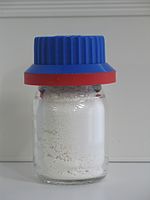- BCDMH
-
BCDMH 
 1-bromo-3-chloro-5,5-dimethylimidazolidine-2,4-dioneOther namesbromochloro-5,5-dimethylhydantoin, BCDMH, agribrom, aquabrom, aquabrome, bromicide, di-halo, halogene T30, nylate, photobrome, slimicide 78P
1-bromo-3-chloro-5,5-dimethylimidazolidine-2,4-dioneOther namesbromochloro-5,5-dimethylhydantoin, BCDMH, agribrom, aquabrom, aquabrome, bromicide, di-halo, halogene T30, nylate, photobrome, slimicide 78PIdentifiers CAS number 16079-88-2 
PubChem 31335 ChemSpider 29069 
Jmol-3D images Image 1 - O=C1N(Br)C(=O)N(Cl)C1(C)C
Properties Molecular formula C5H6BrClN2O2 Molar mass 241.47 g/mol Appearance White solid Density 1.9 g/cm3 Melting point 159–163 °C
Solubility in water 0.15 g/100 ml (25 °C) Hazards MSDS External MSDS R/S statement S8, S17, S26, S36, S37, S39, S41, S45 Main hazards Flamability, Inhalation NFPA 704 Flash point Decomposes at 160°C  (verify) (what is:
(verify) (what is:  /
/ ?)
?)
Except where noted otherwise, data are given for materials in their standard state (at 25 °C, 100 kPa)Infobox references 1-Bromo-3-chloro-5,5-dimethylhydantoin (BCDMH) is a chemical structurally related to hydantoin. It is a white crystalline compound with a slight bromine and acetone odor and is insoluble in water, but soluble in acetone.
BCDMH is an excellent source of both chlorine and bromine as it reacts slowly with water releasing hypochlorous acid and hypobromous acid. It used as a chemical disinfectant used for recreational water and drinking water purification. BCDMH works in the following manner:[1]
The initial BCDMH reacts with water (R = Dimethylhydantoin):
Hypobromous acid partially dissociates in water:
- HOBr → H+ + OBr-
Hypobromous acid oxidizes the substrate, itself being reduced to bromide:
- HOBr + Live pathogens → Br- + Dead pathogens
The bromide ions are oxidized with the hypochlorous acid that was formed from the initial BCDMH:
- Br- + HOCl → HOBr + Cl-
This produces more hypobromous acid. However, the hypochlorous acid itself does act directly as a disinfectant in the process.
Preparation
This compound is prepared by first brominating, then chlorinating 5,5-dimethylhydantoin:[2]
References
- ^ South Australian Health Commission, "Standard for the Operation of Swimming Pools and Spa Pools in South Australia", Supplement C: Bromine Disinfection, page 8. Retrieved on 2009-05-12.
- ^ Yasukazu Ura, Gozyo Sakata (2005), "Chloroamines", Ullmann's Encyclopedia of Industrial Chemistry, Weinheim: Wiley-VCH, doi:10.1002/14356007.a06_553
External links
Categories:- Disinfectants
- Organobromides
- Organochlorides
- Hydantoins
Wikimedia Foundation. 2010.


